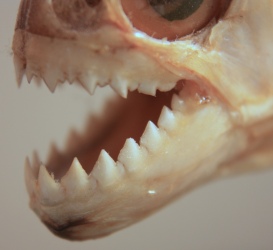 Pirhana are freshwater fish, and the total number of piranha species is unknown. These fish inhabit South American rivers, lakes and reservoirs. Although often described as extremely predatory and mainly feeding on fish, their dietary habits are varied, and they also will eat plant material, meaning they are actually omnivorous. Depending on the species, most piranhas grow to between 12 to 35 cm long. A few can grow larger, with the largest living species, the red-bellied pirhana, reaching up to half a metre in length!  All piranhas have a single row of sharp teeth in both jaws used for rapid puncture and shearing. Individual teeth are typically triangular, pointed, and blade-like.
Piranhas have one of the strongest bites found in bony fishes, and relative to body mass, the black piranha produces one of the most forceful bites measured in any vertebrate. This extremely powerful and dangerous bite is generated by large jaw muscles that are attached to the tip of the jaw, which is a highly modified third-class lever that favours force production over bite speed. Strong jaws combined with finely serrated teeth make them adept at tearing flesh.
All piranhas have a single row of sharp teeth in both jaws used for rapid puncture and shearing. Individual teeth are typically triangular, pointed, and blade-like.
Piranhas have one of the strongest bites found in bony fishes, and relative to body mass, the black piranha produces one of the most forceful bites measured in any vertebrate. This extremely powerful and dangerous bite is generated by large jaw muscles that are attached to the tip of the jaw, which is a highly modified third-class lever that favours force production over bite speed. Strong jaws combined with finely serrated teeth make them adept at tearing flesh.
Piranhas, especially the red-bellied, have a reputation as ferocious predators that hunt their prey in schools. Recent research, however, suggests that they are timid fish that school for protection from their own predators, such as cormorants, caimans, and dolphins. Piranhas are just regular fish with large teeth.  In addition to fish (occasionally even their own species), documented food items for piranhas include other vertebrates (mammals, birds, reptiles), invertebrates (insects, crustaceans), fruits, seeds, leaves and detritus.
In addition to fish (occasionally even their own species), documented food items for piranhas include other vertebrates (mammals, birds, reptiles), invertebrates (insects, crustaceans), fruits, seeds, leaves and detritus.
Piranhas lay their eggs in pits dug during the breeding season and swim around to protect them. Newly hatched young feed on zooplankton, eventually moving on to fish once they're grown. Plankton are aquatic plant or animal organisms that are unable to swim effectively against currents. Consequently, they drift or are carried along by currents in the ocean, lakes or rivers. Phytoplankton are plants which manufacture their own food; zooplankton can't make their own food and must survive by consuming other organisms.Piranha teeth are often used by humans as tools themselves, for carving wood or cutting hair, or to modify other tools, such as sharpening of darts. This practice has been documented among several South American tribes. Piranhas are also popular as food. However, they are often considered a nuisance by fishermen because they steal bait, eat catches, damage fishing gear, and may bite when accidentally caught.  Although often described as extremely dangerous in the media, piranhas typically do not represent a serious risk to humans. However, attacks have occurred, especially when the piranhas are in a stressed situation such as the dense groups that may occur when the water is lower during the dry season and food is relatively scarce. Swimming near fishermen may increase the risk of attacks due to the commotion caused by struggling fish and the presence of bait in the water.
Although often described as extremely dangerous in the media, piranhas typically do not represent a serious risk to humans. However, attacks have occurred, especially when the piranhas are in a stressed situation such as the dense groups that may occur when the water is lower during the dry season and food is relatively scarce. Swimming near fishermen may increase the risk of attacks due to the commotion caused by struggling fish and the presence of bait in the water. Splashing attracts piranhas and for this reason children are more often attacked than adults. Being in the water when already injured or otherwise incapacitated also increases the risk. Most piranha attacks on humans only result in minor injuries, typically to the feet or hands, but they are occasionally more serious and very rarely can be fatal.  Various stories exist about piranhas, such as how they can skeletonize a human body or cattle in seconds. These legends refer specifically to the red-bellied piranha, and are not based in fact. A common falsehood is that they can be attracted by blood and are exclusively carnivores. These legends were dismissed through extensive research. |